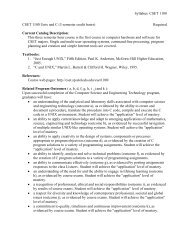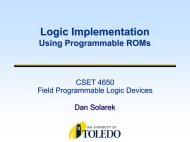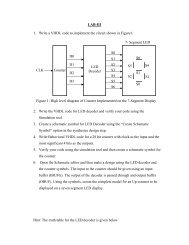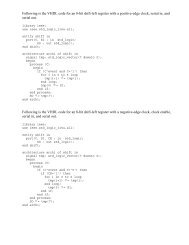Programmable Logic and Application Specific Integrated Circuits
Programmable Logic and Application Specific Integrated Circuits
Programmable Logic and Application Specific Integrated Circuits
Create successful ePaper yourself
Turn your PDF publications into a flip-book with our unique Google optimized e-Paper software.
core, a DMA or memory controller, or a complete I/O subsystem) from which the designer can<br />
compose a complex ASIC.<br />
3. Gate Array Design<br />
Full custom <strong>and</strong> st<strong>and</strong>ard cell design methodologies require custom chip fabrication using a<br />
complete set of unique masks which define the semiconductor processing of the design. Thus, both<br />
the NRE cost for the mask set <strong>and</strong> the design turn-around time through the foundry are quite high.<br />
As an alternative, a chip design can be created using a custom interconnection pattern on an array<br />
of uncommitted logic gates (i.e. a gate array). Wafers of chips containing the uncommitted logic<br />
gate arrays can be pre-fabricated up to the point of the final metalization steps which create the<br />
logic personalization. Compared to st<strong>and</strong>ard cell or full custom designs, the design turnaround<br />
time <strong>and</strong> cost are reduced because only the top level interconnect <strong>and</strong> contact mask steps (2-5<br />
masks) need to be applied. Several other advantages of these “mask programmed” gate arrays<br />
relate to the economies of scale for this design style. Wafer costs are low because many different<br />
customer designs can be created from the same base wafer design. Similarly, foundry packaging<br />
<strong>and</strong> test costs are low due to st<strong>and</strong>ard pin-outs <strong>and</strong> common test fixtures which can be used for<br />
multiple designs. Section IV will describe gate array design in more detail.<br />
Gate array sales are also growing substantially, but at a slower rate than st<strong>and</strong>ard cells.<br />
They are expected to maintain a relatively constant 34% share of the market through 1998,<br />
corresponding to a predicted dollar sales growth from $3.5 billion to $5.1 billion. 3<br />
4. Field <strong>Programmable</strong> <strong>Logic</strong><br />
A field programmable logic device is a chip whose final logic structure is directly<br />
configured by the end user. By eliminating the need to cycle through an integrated circuit<br />
production facility, both time to market <strong>and</strong> financial risk can be substantially reduced. The two<br />
major classes of field programmable logic, <strong>Programmable</strong> <strong>Logic</strong> Devices (PLDs) <strong>and</strong> Field<br />
<strong>Programmable</strong> Gate Arrays (FPGAs), have emerged as cost effective ASIC solutions because they<br />
provide low-cost prototypes with nearly instant “manufacturing”. This class of device consists of<br />
an array of uncommitted logic elements whose interconnect structure <strong>and</strong>/or logic structure can be<br />
personalized on-site according to the user’s specification. Section III of this chapter will discuss<br />
the design alternatives for this class of ASIC in more detail. Field programmable logic devices<br />
are expected to grow from the 1993 world wide sales level of 11% to at least 17% by 1998. 3<br />
Table 1 summarizes the current ASIC worldwide market <strong>and</strong> indicates the forcasted trends.<br />
Although field programmable logic represents only a small percentage of total ASIC market sales,<br />
statistics indicate that approximately one half of all chip design projects today are begun using<br />
FPGAs. 4<br />
6
















